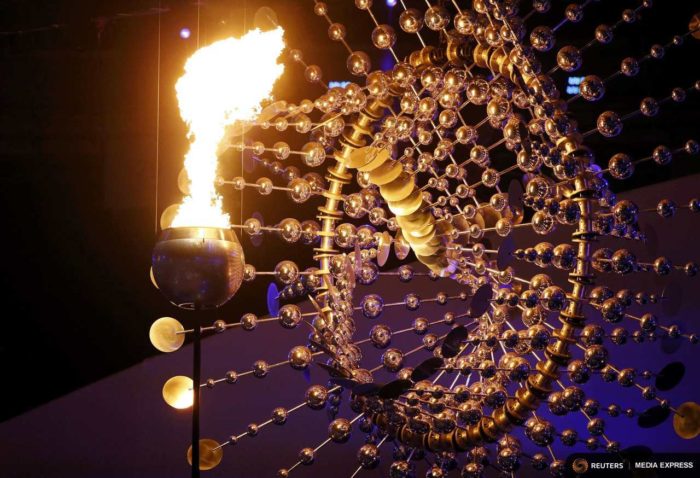
Orcas Island’s tiny artistic community hit the world stage last Friday night during the opening ceremony of the 2016 Summer Olympics.
Anthony Howe, who has called the island home since 1994, designed the kinetic wind sculpture framing the Olympic cauldron in Rio’s Maracaña Stadium. Seventy eight thousand people attended the ceremony and some estimates put worldwide viewership in the billions.
In an opening ceremony that generated widespread acclaim – in contrast to the social and political turmoil surrounding the Rio Games – art critic Sarah Cascone said Howe’s piece “stole the show,” trumping even supermodel Gisele Bündchen on her last catwalk strut.
The two-ton metal and glass artwork is a variation on his piece “Lucea,” whose steel base was cast in Walla Walla. At the ceremony, the sculpture appeared to envelop the cauldron like a vortex from its suspended position in midair, where it gently pulsed in the breeze.
Following a budget-conscious but visually stunning ceremony that retold Brazil’s history (warts and all, including explicit references to slavery) Howe’s artwork capped off the night when Brazilian marathoner Vanderlei Cordeiro de Lima lit the Olympic cauldron, the flames rising to meet the sculpture.
“My vision was to replicate the sun, using movement to mimic its pulsing energy and reflection of light,” Howe said in a press release before the ceremony. “I hope what people take away from the cauldron, the Opening Ceremonies, and the Rio Games themselves is that there are no limits to what a human being can accomplish.”
Howe’s choice was apropos given the themes pursued by the ceremony’s creative director, filmmaker Fernando Meirelles (“City of God,” “The Constant Gardner”). Following the historical narrative of the host country, the ceremony’s story arc expanded to encompass a broader message warning of the dangers of climate change. An announcer recounted basic facts about the threat of increasing temperatures. Video montage illustrated melting ice cap and sea-level rise scenarios that would wipe out cities, including Rio, which arguably birthed the modern sustainability movement when it hosted the 1992 U.N. Earth Summit and its more recent follow-up, Rio +20, in 2012.
Acknowledging the potential controversy ahead of the environmentally-charged ceremony, director Meirelles tweeted in Portuguese, “Bolsanaro [a conservative Brazilian lawmaker] will hate the ceremony. Trump too. That much we’re certain of.” Political newspaper The Hill summarized the conservative backlash in the U.S. following the ceremony.
Howe, meanwhile, says he drew inspiration from the host country’s tropical vegetation with nods toward coconut and palm trees in the metal spheres and orbs that give form to his 40-diameter sculpture.
In his press release, he said that the invitation to design a piece for the Olympics came unexpectedly. He is an accomplished artist, with public installations on display in Dubai and Southern California, as well as Howe-inspired pieces at the Burning Man art festival.
Whether the Rio Games will live up to its aspirational opening message, meanwhile, is up for debate. On the eve of the opening ceremony, ThinkProgress reported on the gap between Rio Mayor Eduardo Paes’ outspoken leadership as president of the C40 Cities Climate Leadership Group (Seattle, Portland, and Vancouver are all members) and the reality of his administration, which presided over severe environmental degradation in the run-up to the Olympics. Reporter Natasha Geiling called the games “an ecological disaster.”
But Rio residents looking for environmental inspiration in the wake of the games can take solace in Howe’s sculpture. A smaller version of the opening ceremony behemoth will remain on permanent display in front of the Candelária church in downtown Rio for all the city to see.
Correction: A previous version of this article incorrectly stated that Anthony Howe sculptures were displayed at Burning Man.


We thank Mr. Howe for devoting his time and magnificent talent and engineering skills to give us all such pleasure in observing his art.
We live in Gig Harbor Washington and Orcas Island is one of our favorite places in this hemisphere. Our dear friend of many years was Hobie Alter who made Orcas Island his home for most of his adult life and introduced this fine place to us and many other of his friends.
We would love to come to Orcas and see Mr. Howe’s work if that is possible. We are not sure whether it is on display but would like to know.
Thank you for reading our message.
Robert and Cheryl Carey